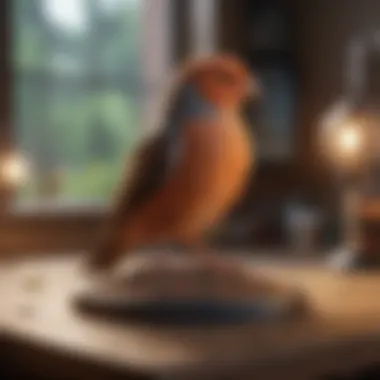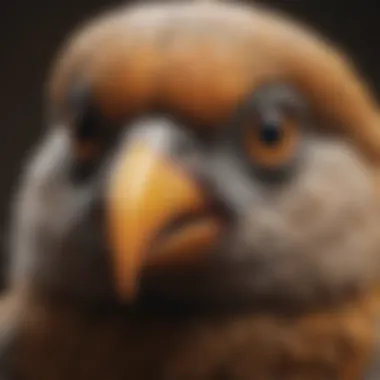Ensuring Safety of Pet Birds During Pregnancy: A Guide


Intro
Navigating the path of pregnancy brings excitement, but it also requires adaptation in caring for your pet birds. Pet owners need to acknowledge the unique demands that arise during this period. While expecting parents focus on their impending changes, it is vital to ensure the well-being of their avian companions. Understanding the intersection of pregnancy and avian care is crucial to mitigate potential stressors both for the birds and the caregiver.
This article addresses key aspects that can significantly influence the health of pet birds during such times. From nutrition and interaction habits to identifying signs of stress, an informed approach cannot be understated. Ferthermore, we will address how different bird species may require distinct forms of care to thrive alongside their humans.
Every bird is waiting for recognizing the signs and nuances that affect them. Therefore, owners must remain vigilant in both routine care and emotional support in this very important time.
Avian Care Basics
Caring for pet birds involves an understanding of their specific needs. During a caregiver's pregnancy, some considerations need to be heightened. It is not only about maintaining routine but also prioritizing emotions and environment.
Importance of Proper Nutrition
Birds require a balanced diet composed of seeds, fruits, and vegetables. During pregnancy, caregivers may find it tempting to overlook dietary adjustments amid other concerns. However, ensuring that your bird receives vital nutrients can profoundly influence their health. Each species has unique dietary needs. Learning these requirements and tailoring food accordingly can avoid many issues later.
Understanding Bird Species and Their Needs
Diverse bird species come with different behavioral patterns and lifestyle expectations. It is essential to catalog what species you own and their distinctive characteristics. For instances, species such as budgies require ample playtime and room to fly, while lovebirds display a stronger need for social interaction. Understanding these preferences leads to better accommodations.
Basics of Birds Habitat Setup
Create a safe environment personalized to your birds' demands. Ensure cages are spacious, secure, and equipped appropriately. Include feeding areas, play spaces, and retreats. Pay attention to item placements, as birds can often feel more comfortable and made safer with their items designed for their experience.
Grooming and Hygiene Tips
Periodic grooming maintains your bird's health. Be mindful of nails and beak care. Removal of feathers, when necessary, is believed to carry substantial psychological impacts; hence ensure it is carried out with proper guidance. Regular cleaning of cages and items helps reduce sickness, making it essential, especially during expecting periods.
"Healthy birds thrive when provided with attention to dietary, habitat, and grooming needs—these lead to flows of positivity that affect overall health."
Interacting with Your Pet Bird
The emotional bond with your avian companion significantly influences their happiness. Engaging with them requires sensitivity, especially during the caregiver's pregnancy.
Building Trust and Connection
Developing trust with your birds demands patience. Spend quiet time with them, talk softly, and offer treats. These actions help foster feelings of safety and comfort.
Training Techniques and Tips
Training methods enhance communication. Start small with commands like
Prelude to Pet Birds and Pregnancy
Understanding the interactions between pet birds and their caregivers takes on heightened significance during times of personal transition, such as pregnancy. This phase, filled with physical and emotional changes, can create challenges for maintaining the well-being of beloved avian companions. It is essential to explore measures that not only serve to protect birds as individuals but also preserve their bond with their caregivers. This article brings relevant discussions around risks and recommendations, drawing a timeline that aligns a caregiver's new responsibilities with the needs of their feathered friends.
Understanding the Bonds Between Birds and Caregivers
The connection between pet birds and their caregivers often mirrors the rich, complex relationships seen in many human-animal interactions. This attachment grows over time, and understanding this bond is crucial, especially when caregivers are navigating pregnancy. Birds are social creatures often displaying loyalty and affection towards their human companions. As environmental and social cues shift, it becomes necessary to be aware of how these changes impact birds. During pregnancy, caregivers might be less available, both physically and emotionally, which can affect their birds.
It is critical to comprehend that repeated interactions, familiar voices, and routines contribute significantly to a bird’s mental health. Knowing their birds’ preferences in terms of interaction and lifestyle can mitigate stress. Creating consistent schedules proves beneficial in reassuring pet birds throughout periods of unexpected changes.
The Importance of Preparing for a New Life


Preparation recaptures the essence of maintaining safety and a stable atmosphere for birds in a caregiver's life, especially amid pregnancy. Challenges can mount as expecting parents shift their focus toward welcoming a new child into their lives. Concurrently, pet birds rely on a sense of security derived from a consist environment and attentive handling.
Starting early can make a significant difference. Identifying potential stressors, such as new household dynamics or space adjustments, will inform necessary alterations in a bird’s habitat. Some beneficial strategies include:
- Reducing loud noises and sudden movements that may startle birds.
- Establishing safe areas in the home where birds can retreat from commotion.
Furthermore, caregivers must ensure that they execute gradual changes to minimize disturbances. Adequate preparation becomes a matter of protecting the integrity of both the caregiver's recovery period and the beloved animal's routine, guarding against potential stressors or health risks during such a transformative phase.
"Being proactive in preparing for both parental duties and pet care can create a harmonious and thriving environment for all.
With proper understanding and foresight, transitioning through a phase of life like pregnancy involves accommodating every member of the family, including pet birds. As this article unfolds, it will address crucial concerns about accompanying responsibilities while fostering these vital relationships.
Potential Risks to Pet Birds During Pregnancy
Caring for pet birds during pregnancy involves understanding specific risks. Expecting caregivers often focus on personal health but may overlook their birds’ well-being. The change in household dynamics can pose threats to pet birds. Identifying these potential risks aids caregivers in creating a safer environment for their feathered companions.
Chemical Exposure and Its Effects
Chemical exposure is a major concern. Pregnant individuals may use products that emit fumes or chemicals harmful to birds. Common household items such as cleaning products, air fresheners, and certain paints can become toxic. Birds have sensitive respiratory systems, and even minor amounts can lead to serious health issues.
It is crucial to carefully read labels and look for pet-safe alternatives. During pregnancy, the focus should be on non-toxic cleaning supplies like vinegar or baking soda. If possible, keep birds in a separate space while cleaning. It limits their exposure to irritating vapors, while still maintaining their safety.
Creating a Safe Environment
Creating a safe environment for pet birds during a caregiver's pregnancy is pivotal. This setting not only protects the physical well-being of the birds, but also reduces the stress levels they may experience during this significant transition. There are specific elements to consider when modifying the habitat and establishing a reliable routine. Addressing these components is essential to ensure that both the caregiver and their avian companions adapt smoothly to changes.
Habitat Modification for Safety
Modifying the habitat is crucial to protect birds from hazards. Different aspects must be taken into account when setting up the living space for pet birds. Safety features can include preventing exposure to harmful substances, reducing environmental stressors, and enhancing overall well-being.
- Reduce ornate visual stimuli: Birds are sensitive to their surroundings. Removing objects that may cause distraction, fright, or aggression is important. For example, avoid large mirrors, as kisses can thwart contentment.
- Secure cages: Ensure the cages are sturdy and secure. It is best to check all locks and hinges frequently to prevent escapes.
- Ventilation: Fresh airflow should circulate well throughout the living area. Proper ventilation can minimize exposure to dust and allergens.
- Chemical safety: Identify and eliminate unsafe cleaning products, which may introduce harmful chemicals to the environment. Use bird-safe cleaning strategies, such as vinegar and baking soda, when sanitizing.
- Outdoor precautions: Comditionally made balloons can abstract of owners. Leaving your pet outside for longer transfomedoythering periods may expose them to predators or injuries; always supervise if taking them outdoors.
Establishing a Routine for Care
Establishing a consistent routine is vital for pet birds, particularly during times of change. This regular schedule can aid in alleviating anxiety while contributing to feeling secure. A predictable daily schedule allows birds to experience comfort and stability.
Benefits of having a routine include:
- Feeding times: A set daily feeding regimen can reduce stress. Use quality foods tailored to your bird species. Maintaining their dietary needs is crucial.
- Interaction: Schedule time for bonding or playful activities. This helps build trust and eases potential display of jealousy towards a new family member. Varied interactions can strengthen your bond.
- Rest periods: Birds require adequate downtime. Ensuring they have quiet time for resting helps maintain their mental health. Regular dark cycle simmulates their natural habitat lighting.
- Health check-ins: Include daily short assessments to observe for any health changes. Being vigilant can help catch issues early on.
Key Point: A safe environment promotes the emotional and physical well-being of pet birds, ensuring they can adjust positively amid the caregiver's pregnancy. Estabishment of a heallthy stratum for both parties is critical all the time.
Species-Specific Considerations
Understanding the unique needs of various pet bird species is critical during a caregiver's pregnancy. Each type of bird has different behaviors and requirements that can be influenced by environmental stresses or changes in routine. By recognizing these species-specific needs, caregivers can create a more supportive atmosphere for their feathery companions. This tailored care can promote health and happiness among avian friends.
Parakeets and Their Unique Needs
Parakeets are popular pet birds that require particular care and attention. They are social creatures and rely on interaction with their caregivers. During pregnancy, changes in the household's routine may cause stress for these birds. They may feel the absence of consistent bonding time. Therefore, it is essential to maintain as much interaction as possible.
To address their needs, caregivers should:
- Ensure daily social engagement.
- Provide a distraction with toys and puzzles.
- Maintain their diet with fresh fruits and high-quality seed mix.
Keeping parakeets stimulated and confident during this period is vital. Stress can lead to health concerns like feather plucking or loss of appetite. This makes it necessary for a caregiver to track any behavioral shifts.


Cockatiels: Care Guidelines
Cockatiels share similarities with parakeets but also have specific demands that should not be overlooked. They appreciate companionship and can develop strong bonds with their human caretakers. Maintaining routine in feeding, play, and talking remains essential to their well-being.
Considerations for cockatiels include:
- Allowing them playtime outside the cage under supervision.
- Providing sufficient space for flying.
- Rotating toys to prevent boredom.
Proper nutrition is also crucial to their stability. A varied diet that includes pellets, fruits, and occasional grain will enhance their physical health. Intently monitoring their behavior for signs of despondency or stress is a must, as health changes can happen gradually.
Larger Birds: Risks and Responses
Larger bird species, such as African Grey parrots or Macaws, demand further attention due to their size and emotional complexity. These birds can develop attachment issues which make changes in the household especially tough for them. Pregnancy can involve unpredictably and may lead to more anxiety among larger feathered friends.
Suggestions for caretakers of larger birds include:
- Offer a stable environment with familiar objects and routines.
- Introduce gradual changes to their habitat and interactions.
- Provide elevated resting perches to keep them secure.
Monitoring for signs of irritability, feather issues, or changes in vocalization could be beneficial, knowing they may struggle during this shift. Using calm communication can soothe these larger species amid transitions.
Monitoring the Well-Being of Pet Birds
Monitoring the health and well-being of pet birds during a caregiver's pregnancy is essential. The changes in the household dynamics can introduce new stressors for birds. Without observation, these stressors can impact their health. A caregiver’s awareness of their pet's state, as well as the adjustments needed in their care routine, fosters a nurturing environment for both the bird and the expecting parent.
Recognizing Signs of Distress
Birds are incredibly sensitive creatures and exhibit distinct behaviors when they are distressed. These signs are crucial for caregivers to notice, especially in a busy time like pregnancy. Common indicators include:
- Change in vocalizations: An increase or decrease in chirping and talking can signal discomfort.
- Feather plucking: Excessive grooming can show stress or anxiety related to changes in their environment.
- Isolation: A bird that withdraws from social interaction may feel unwell or unsafe.
Caregivers are encouraged to observe their birds closely and create a log of any behaviors that seem unusual. Keeping routines consistent can help each bird feel more secure. Any sudden or ongoing changes in behavior may warrant further discussion with an avian veterinarian, who can provide guidance tailored to the specific bird's needs.
Behavioral Changes to Watch For
In addition to distress signs, certain behavioral changes can signify broader health issues. This may include:
- Loss of appetite: A bird that refuses food could be experiencing a range of issues from illness to stress.
- Sleeping more: If a bird is sleeping excessively, it could indicate a response to environmental changes. A keen eye on routine activity is vital to identify such shifts.
- Aggression or territorial behavior: Birds may act aggressively when feeling threatened. An understanding of baseline behavior helps differentiate between normal and concerning aggression.
By remaining vigilant, caregivers may mitigate potential issues before they escalate. Continuous monitoring supports the overall emotional and physical state of the bird. Building a firm understanding of each bird's behavior aids caregivers navigate the complexities of their flock's well-being during this transitional phase.
Tips for Bird Care During This Transition
The topic of maintaining pet birds during a caregiver's pregnancy is critical. This time may bring changes that impact both the expecting parent and the avian companions. The goal is to provide insights and strategies for alleviating stress on birds while enhancing their care. This should include aspects such as food, diet adjustments, and understanding behavioral needs.
Nutrition and Diet Adjustments
Proper nutrition is vital when it comes to ensuring pet birds thrive. Just as caregivers must pay attention to their own dietary needs during pregnancy, so should they consider the nutritional demands of their feathered friends. Feeding practices may require adjustments to maintain their health during this transitional phase. Spread out food into smaller portions throughout the day to accommodate more tailored feeding routines. This would help in regular monitoring of their consumption.
Pet birds can benefit from a varied diet, which generally includes seeds, pellets, fruits, and vegetables. Evaluate your current feeding plan to ensure vitamins and minerals are sufficient, especially if pursuing a species-specific approach. Some birds may benefit from more leafy greens such as spinach or kale, while others might require additional protein sources, like boiled eggs.
Additionally, consider a photoperiod of at least 12 hours of light. This affects the metabolic processes related to nutrition. Proper hydration is also essential; fresh water should always be accessible. Take note of any changes in eating habits, as sudden decreases or increases may indicate stress or health issues.
Enhancing Enrichment Activities


Supporting your pet bird's emotional and mental wellness during this time is crucial. Just like nutrition, sufficient enrichment is key to a happy bird. Engaging activities reduce boredom and foster mental stimulation. Periodic changes in their environment can make a difference.
Interactivity can involve toys, as well as various activities adapting to individual needs. Enrichment may include:
- Toys: Rotate their toys regularly to keep the environment stimulating and exciting.
- Foraging: Encourage natural behaviors by hiding food or treats within their toys or in different areas of the bird’s habitat.
- Socialization: Allocate time during the day for talking and playing with your bird to keep bonds strong and reinforce social behavior.
- Safe Exploration: If safe, allow for supervised free time outside of their cage. This process can help reduce stress from confinement.
- Training Sessions: Incorporate short training sessions using positive reinforcement.
These activities can mitigate mild stress and allow for the establishment of a more profound connection between the caregiver and the bird. Stress often manifests in various ways, from feather plucking to decreased vocalization, leading to worsened health parameters. Hence, maintaining mental and physical stimulation is equally essential to nutrition, ultimately benefiting both the bird and the caregiver.
It's crucial during this period to remain observant, realizing birds may signal distress or discomfort differently than expected. Caring involves various aspects—diet, enrichment, and monitoring. Findings show interaction can significantly influence wellness and behavior.
Consulting Avian Veterinarians
Consulting avian veterinarians is a critical element for ensuring the health and safety of pet birds during pregnancy. As the caregiver experiences physical and emotional changes, it is essential to maintain a proactive approach toward avian care. An avian veterinarian specializes in bird health, making them an invaluable resource for understanding the specific needs of your feathered companions during this transitional period.
Collaborating with an avian vet offers several benefits. First, these professionals can provide guidance tailored to your specific species of bird, their unique health needs, and habitat considerations. For instance, finches may experience different challenges than parrots. Additionally, regular vet check-ups can help identify health issues early, which is vital because an undiagnosed pain or disease can escalate.
Another critical aspect involves assessing the effects of your changing environment on your birds. A vet can offer tactics to ease possible stress responses caused by alterations in household dynamics. Moreover, professional advice ensures that birds receive appropriate nutrition and enrichment, vital for their overall well-being, especially during the unpredictable times of pregnancy.
Consulting with an avian veterinarian serves both the caregiver and the pet birds significantly. Proper vet guidance reduces anxiety and promotes smooth coexistence during this unique life period.
When to Seek Professional Advice
It's essential to know the right moments to seek advice from an avian veterinarian. As a reference, pay attention to the following signs:
- Behavioral Changes: If your bird shows sudden lethargy or aggression, it might be a signal for concern.
- Physical Symptoms: Any signs of feather plucking, changes in droppings, or weight loss should not be ignored.
- Changes in Appetite: A decrease in food or water intake can indicate underlying health issues that need prompt attention.
- Injuries or Illness: If accidents occur or if you suspect your bird is sick, immediate veterinary consultation is crucial.
Addressing these situations early can prevent minor issues from turning into major health crises.
Choosing the Right Avian Vet
Selecting the appropriate avian veterinarian is equally important. Here are key points to consider:
- Specialization in Birds: Vets should specifically focus on avian medicine. Check their qualifications to see if they hold certifications in this area.
- Experience with Species: Ensure the vet has experience treating your specific kind of bird; each species can have unique requirements.
- Clinic Environment: A clean and well-maintained clinic is essential for patient safety, indicating the vet’s professionalism.
- Communication Style: It is vital that the vet can communicate effectively and answer your questions clearly. This builds trust in the caregiver-vet relationship.
- Referrals and Reviews: Seek recommendations or reviews from fellow bird owners. Grasping others' experiences can help in making an informed decision.
Income effectively steering you towards decision-making helps safeguard your birds’ health. Regular visits to an avian doctor ensure that your companion thrives throughout your pregnancy while maintaining balance in their own environment.
The End and Future Considerations
In the journey of caring for pet birds during the pivotal time of pregnancy, understanding and preparing for the long-term implications is vital. This article emphasizes how the expectations of parenthood extend beyond the expecting caregiver to their feathered companions. Ensuring safety for pet birds is not just a phase but a continuous process that aligns with thoughtful preparation, awareness, and attentive care.
Long-term Care Practices
Practices for the long term typically involve ongoing routines that reflect an understanding of both birds' needs and the changes in the household. Post-pregnancy, caregivers may find their time limited. So, having established systems can allow birds to thrive amid lifestyle changes. Regular veterinary check-ups are paramount. Win the trust of an avian vet to craft and maintain a health plan beneficial for each species. Adjusting diets to emphasize nutritional needs without complicating daily routines also help ensure the health of birds over time. Establishing a feeding schedule aligned with the caregiver's schedule makes the process manageable.
Monitoring behavior consistently provides insight into health and stress levels. Regular monitoring can reveal subtle signs of distress. Modifications in routine based on these observations become essential. Emphasizing safe spaces within your home is another key aspect. Birds should have accessible hideaways to retreat when needed.
Useful activities to enrich their environments play a role in long-term care. Simple installations, such as convenient perches and interactive toys, should be regularly reviewed and replaced to stimulate birds. Ongoing training also engages their minds and strengthens bonds with caregivers.
- Regular vet visits
- Attentive feeding schedules
- Clear monitoring of behaviors
- Enrichment and stimulation activities
The Ongoing Relationship Between Birds and Caregivers
Acknowledging the ever-evolving bond between birds and caregivers leads to a better understanding of mutual needs. Relationships require deep attention, especially in an environment that challenges both parties. Complicated circumstances arise that can strain interactions. Awareness helps foster stronger connections even when challenges exist. Regular engagement through vocalization or gentle interaction fosters trust and comfort.
The social nature of many birds necessitates the caregiver’s continuous involvement. Through play and training, they enrich the relationship and uncover layers of personality that keep it engaging. Caregivers must remain vigilant in prioritizing interactions that reinforce trust. This deepened connection means recognizing the demands of a transitioning household during pregnancy yet giving birds firm attention still remains necessary.
Also, taking reflections on mutual needs must be part of ongoing considerations. As both birds adapted to their owner's new role, open platforms for observing each other’s changes bolster the companionship and support caregiving strategies.
The essence is that the journey is about creating a shared life that fosters the welfare of both avian friends and their human caregivers.
As time passes, understanding how to accommodate everyone's changing needs contributes to the well-being of the home and its inhabitants for years ahead.















